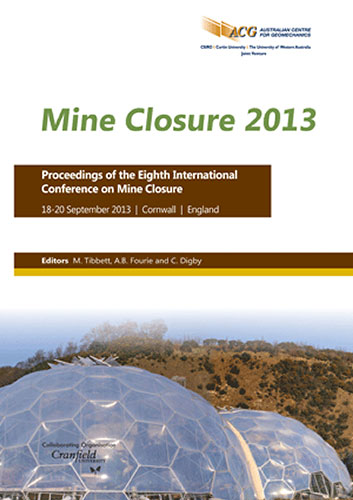Two-layer soil covers on selected radioactive waste rock dumps at Wismut: results of more than ten years of hydrological monitoring

|
Authors: Schramm, A; Roscher, M |
DOI https://doi.org/10.36487/ACG_rep/1352_18_Schramm
Cite As:
Schramm, A & Roscher, M 2013, 'Two-layer soil covers on selected radioactive waste rock dumps at Wismut: results of more than ten years of hydrological monitoring', in M Tibbett, AB Fourie & C Digby (eds), Mine Closure 2013: Proceedings of the Eighth International Seminar on Mine Closure, Australian Centre for Geomechanics, Cornwall, pp. 207-222, https://doi.org/10.36487/ACG_rep/1352_18_Schramm
Abstract:
In East Germany, uranium mining and milling by the Soviet-German Wismut Company lasted from 1946 to 1990. The Wismut uranium mining area consists of numerous waste rock dumps (WRDs) in Saxony and Thuringia. The waste rock is classified as radioactive and it is partially susceptible to acid rock drainage. The different cover systems obstruct direct contact with radioactive waste rock, prevent dust and limit radon emission and oxygen ingress. In contrast to the cover system of WRD Beerwalde in Thuringia, the systems at the Schlema site in Saxony were not designed to control the percolation rate but to limit the radon emission. The Schlema region experiences an average mountain climate, with a mean annual precipitation of 890 mm (range: 590–1340 mm). The climate at WRD Beerwalde can be characterised as moderately humid, with a mean annual precipitation of 715 mm (range: 452–1086 mm). The cover of the dumps at the Schlema site, located very close to residential areas, consists of a moderately compacted storage layer (0.8 m mineral soil made of sandy silt) and a 0.2 m thick organic vegetation layer. The major part of the WRD Beerwalde is covered by a two-layer cover consisting of a 1.5 m thick storage layer underlain by a 0.4 m thick compacted sealing layer made of clayey loam. This paper presents the case studies of WRD Borbachdamm and WRD 366 at the Schlema site, covered in 2000 and 2004, and the WRD Beerwalde covered and afforested until the end of 2002. Local soil hydrological monitoring systems were installed immediately after cover construction to measure the daily water balance components. Each measurement system consists of lysimeters to record the amount of seepage as well as various soil probes (tensiometer/equitensiometers, soil moisture meters) to record the dynamics of soil water in the cover. The results show the water balance development of the soil covers, with time as a function of plant growth and exposition. Percolation rates of about 26–34% of annual precipitation at the Schlema site and of 2–20% at the Beerwalde site were observed. An obvious rise of tension as a consequence of an increasing water demand of plants was noted several years after first seeding. Furthermore, there was a rising difference between minimum and maximum soil moisture during the growing season due to a denser vegetation cover. The daily water balances were modelled annually, calibrated with the measured data and checked against the annual amount of seepage. The modelling results at the Schlema site show the expected change of the hydrological balance, with actual evapotranspiration increasing from 300 to 600 mm/year and percolation decreasing from 500 to 250 mm/year. In contrast to the WRDs at the Schlema sites, the annual percolation rates at WRD Beerwalde have increased due to rising evapotranspiration rates strongly affected by exposition. The paper concludes with a discussion of the functionality of the various cover systems at the different sites over time with regard to influences of vegetation type, plant growth and exposition.
References:
Jansson, P.E. and Karlberg, L. (2012) Coupled heat and mass transfer model for soil-plant-atmosphere systems, Department of Civil and Environmental Engineering, Royal Institute of Technology.
Löser, R., Schneider, P., Meyer, J., Schramm, A. and Gottschalk, N. (2011), Assessment of Uranium Waste Dump Closure Systems: Results of Long Term Test Fields at the former Uranium Mining Site in Schlema-Alberoda, Germany, The New Uranium Mining Boom, Challenge and lessons learned, pp. 663–672.
Löser, R., Bonim, C., Sahm, C. and Schneider, P. (2012) Datenauswertung und Modellabgleich zu Bodenmessplätzen in der Niederlassung Aue 2011, Chemnitz, 107 p.
O´Kane, M., Roscher, M., Barnekow, U. (2011) Hydrology of Soil covers on Mine wastes – Selected Examples of Wismut and International Experiences – Nachhaltigkeit und Langzeitaspekte bei der Sanierung von Uranbergbau- und Aufbereitungsstandorten, Proceedings des Internationalen Bergbausymposiums WISSYM_2011, 2011, pp. 167-185
Schmidt, M. (2010) HELP – Modellrechnung zum wasserhaushaltlichen Verhalten ausgewählter Testfelder der Wismut GmbH am Beispiel der Halde Beerwalde, bachelor thesis, TU Bergakademie Freiberg.
© Copyright 2025, Australian Centre for Geomechanics (ACG), The University of Western Australia. All rights reserved.
View copyright/legal information
Please direct any queries or error reports to repository-acg@uwa.edu.au
View copyright/legal information
Please direct any queries or error reports to repository-acg@uwa.edu.au